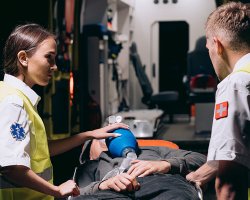The Opioid Epidemic at a Glance

It seems that every time I turn on the TV, check my social media, or open a news tab, I’m assailed with horror stories of our nation’s opioid epidemic. I’ve watched lives get torn apart from opioids. But I’m also frustrated that the media seems to only pull on our heartstrings with the harshest and the most emotional of stories, never really getting to the bottom of the issue of what the opioid epidemic actually is.
So let’s take a few paragraphs and talk about this. Let’s confront the issue, how it started, how it advanced, and what it’s like now. Let’s examine the severity of the issue, and let’s level a harsh stare at those responsible. And last but not least, let’s talk about solutions to the opioid epidemic.
How it All Began
The United States is no stranger to opioids. This is a problem that we've been struggling with for some time. In the late 1990s, the American Medical Association insisted that doctors start treating patients’ pain better. As if answering the call, the pharmaceutical industry offered up opioid pain relievers as the “solution” to patients’ pain. They promised that their pioneer pain reliever drugs (drugs like oxycodone and hydrocodone) would “solve” pain symptoms in patients and that they’d do so with no side-effects and no addiction risk.
America was lied to twenty years ago, and it’s a lie that we’re still believing today.

Fast forward to present day and there are at least two million Americans who are crippled in the throes of an opioid addiction. These could be with either opioid prescription pain relievers, or illegal opioid drugs like heroin or synthetic opioids. Or it could be a combination of the two.
Just last year, the CDC reported that more than seventy-two thousand Americans died from drug overdoses, close to fifty-thousand of which involved an opioid drug. About one-hundred and thirty people die in the U.S. every day due to an opioid drug, according to the U.S. Department of Health and Human Services.
This leads me into the next area that I’d like to cover, which is a brief glimpse at the sheer statistics of opioid addiction in America.
Statistics on the Opioid Epidemic
The website, www.livescience.com penned an impressive overview of the opioid epidemic. Included below are some of their findings, verified against information published by authority research organizations.
According to the Centers for Disease Control and Prevention, since 1999 the number of people who have died from opioid overdoses in the U.S. has almost quadrupled. At this time, the majority of drug overdose fatalities in the U.S. involve an opioid. We live in a country now where drug overdoses cause more deaths than car accidents.
According to the American Society of Addiction Medicine, overdose deaths have increased in tandem with the increasing medicinal use of prescription pain relievers. In fact, ASAM reports that the sale of prescription opioid pain relievers in 2010 was nearly quadruple what it was in 1999. By 2010, enough prescriptions for painkillers were being written to provide every American adult with a bottle of painkillers.
One of the big problems with the opioid epidemic is the fact that opioid misuse often starts with prescription pain reliever misuse, but then it transfers to heroin abuse. According to the Substance Abuse and Mental Health Services Administration, about eighty percent of the people in the United States who are currently addicted to heroin started their substance abuse habits with opioid pain relievers, not with heroin. That means that legal, opioid pain relievers, drugs which are supposed to help us, are now one of America’s top gateway drugs, drugs which incite individuals to go on to using hard, illegal street drugs.

We can’t have a discussion about the opioid problem without talking about fentanyl, the King of the Killers in the opioid drug spectrum. Fentanyl is a synthetic opioid, a powerful and potent pain reliever that was initially synthesized for treating extreme pain in cancer patients alone. Now, fentanyl is used among non-cancer patients, too. Since fentanyl became more popular in the medical industry, it also became more popular in drug-use circles. For example, in Massachusetts, Maine, New Hampshire, Ohio, Florida, Kentucky, Maryland, and North Carolina, the prevalence of strains of fentanyl in drug products seized by law enforcement increased by one-thousand percent in just one year. What is particularly concerning about this is that almost half of all overdose deaths nationwide can be directly attributed to fentanyl, according to the National Institute on Drug Abuse.
It’s mind-numbing, terrible, and saddening that our drug problem has gotten this bad. It’s miserable that our addiction crisis revolves so much around opioids, and it’s even worse that legal drugs have played such a considerable part in this. It’s both shameful and upsetting that we have allowed our nation to buy into the snake-tongued sales pitches of the pharmaceutical industry; that we have allowed ourselves to become chemically and psychologically dependent on the very drugs that were supposed to help us. We’ve made a big mistake with opioids, so how can we get out of the grave that we’ve dug for ourselves?
Breaking Free from the Opioid Epidemic

For every life I’ve seen ruined by the opioid epidemic, I’ve seen one salvaged by it. As crippling as the opioid epidemic is, it’s possible for anyone who is afflicted with a drug problem to be able to break free from that drug problem and tackle life as a sober and recovered individual.
But such an effort does not happen overnight, and very few people can tackle a drug problem without help. Thankfully, drug and alcohol addiction treatment centers are there to help struggling addicts walk the path of recovery, allowing even the most heavily-stricken of addicts to find life anew.
With inpatient addiction treatment, not only do recovering addicts have access to a residential treatment center that can help them address each and every facet of their drug problem, but such individuals are also protected from outside influences, from the risk of being exposed to drugs, and from the threat of having to be around old environments, old drug buddies, old “stomping grounds,” etc.
Inpatient rehab centers offer full detoxification and withdrawal programs to help recovering addicts come down off opioid drugs safely. Such programs offer in-depth approaches to the psychological, spiritual and behavioral sides of a drug problem as well. Such programs are properly configured to meet every need of a recovering addict, creating a safe, pleasant, and supporting environment for them.
Sources:
- https://www.livescience.com/56248-america-opioid-use-epidemic.html
- https://www.drugabuse.gov/related-topics/trends-statistics/overdose-death-rates
- https://www-m.cnn.com/2017/09/18/health/opioid-crisis-fast-facts/index.html


 ®
®